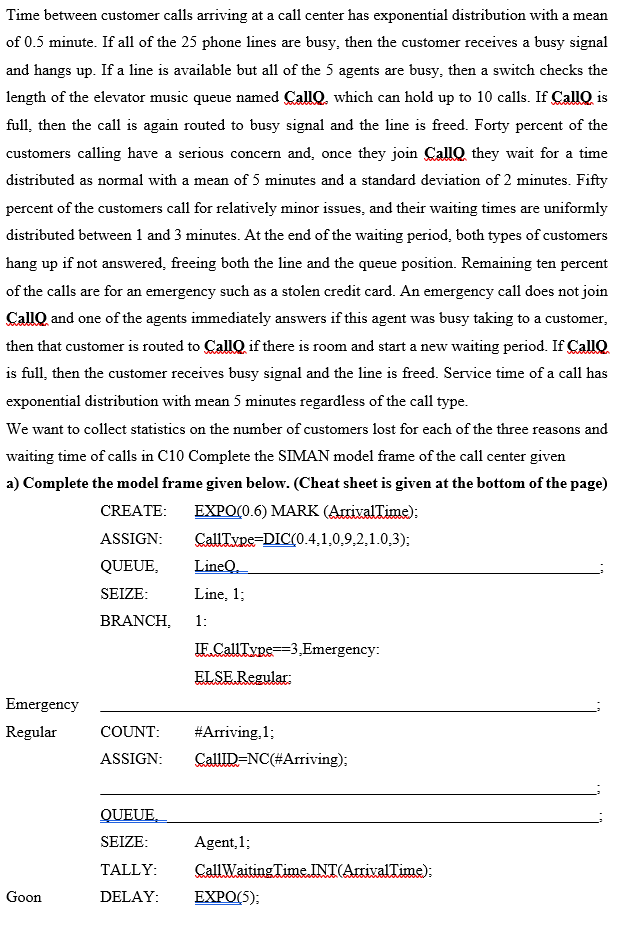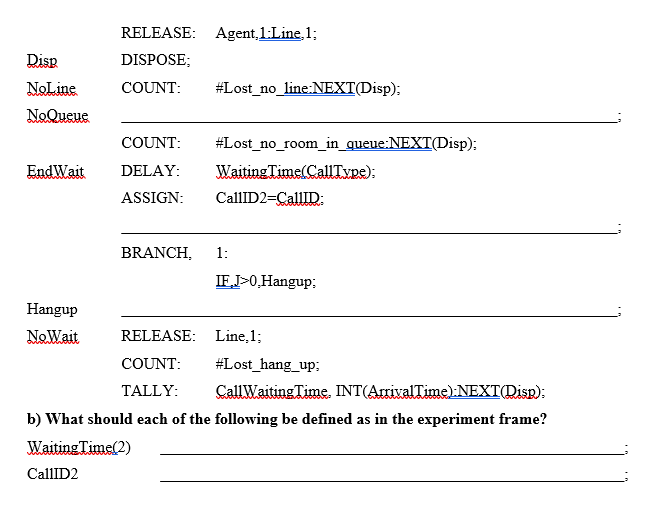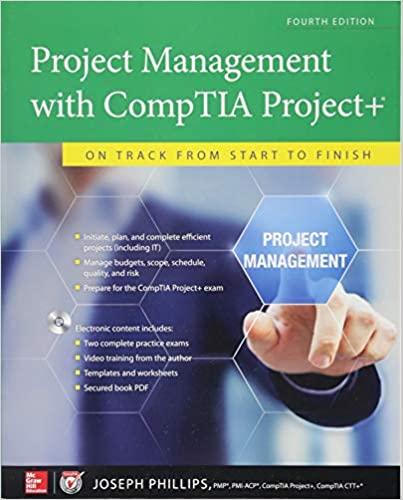Answered step by step
Verified Expert Solution
Question
1 Approved Answer
Time between customer calls arriving at a call center has exponential distribution with a mean of 0.5 minute. If all of the 25 phone lines

 Time between customer calls arriving at a call center has exponential distribution with a mean of 0.5 minute. If all of the 25 phone lines are busy, then the customer receives a busy signal and hangs up. If a line is available but all of the 5 agents are busy, then a switch checks the length of the elevator music queue named CallQ. which can hold up to 10 calls. If CallQ is full, then the call is again routed to busy signal and the line is freed. Forty percent of the customers calling have a serious concern and, once they join CallQ they wait for a time distributed as normal with a mean of 5 minutes and a standard deviation of 2 minutes. Fifty percent of the customers call for relatively minor issues, and their waiting times are uniformly distributed between 1 and 3 minutes. At the end of the waiting period, both types of customers hang up if not answered, freeing both the line and the queue position. Remaining ten percent of the calls are for an emergency such as a stolen credit card. An emergency call does not join CallQ and one of the agents immediately answers if this agent was busy taking to a customer, then that customer is routed to CallQ if there is room and start a new waiting period. If CallQ is full, then the customer receives busy signal and the line is freed. Service time of a call has exponential distribution with mean 5 minutes regardless of the call type. We want to collect statistics on the number of customers lost for each of the three reasons and waiting time of calls in C10 Complete the SIMAN model frame of the call center given a) Complete the model frame given below. (Cheat sheet is given at the bottom of the page) CREATE: EXPO(0.6) MARK (ArrivalTime); ASSIGN: CallType =DIC(0.4,1,0,9,2,1.0,3); QUEUE, LineQ SEIZE: Line, 1; BRANCH, 1: IF CallType==3,Emergency: ELSERegular: Emergency Regular COUNT: \#Arriving, 1; ASSIGN: CallID=NC(\#Arriving); QUEUE, SEIZE: Agent, 1; TALLY: CallWaitingTimeINT(ArrivalTime); Goon DELAY: EXPO(5); \begin{tabular}{|c|c|c|} \hline \multirow{4}{*}{\begin{tabular}{l} Disp \\ NoLine \\ NoQueue \end{tabular}} & RELEASE: & \multirow[t]{2}{*}{ Agent, 1:Line, 1} \\ \hline & DISPOSE; & \\ \hline & COUNT: & \#Lost_no_line:NEXT(Disp); \\ \hline & & \\ \hline \multirow{3}{*}{ EndWait } & COUNT: & \#Lost_no_room_in_queue:NEXT(Disp); \\ \hline & DELAY: & WaitingTime(CallTvpe); \\ \hline & ASSIGN: & CallID2=Callin: \\ \hline \multirow[b]{3}{*}{ Hangup } & BRANCH, & 1: \\ \hline & & IF,J>0, Hangup; \\ \hline & & \\ \hline \multirow[t]{3}{*}{ NoWait } & RELEASE: & Line, 1; \\ \hline & COUNT: & \#Lost_hang_up; \\ \hline & TALLY: & CallWlaitingTime, INT(ArrivalTime):NEXT(Disp); \\ \hline \multicolumn{3}{|c|}{ b) What should each of the following be defined as in the experiment frame? } \\ \hline \multicolumn{3}{|c|}{ WaitingTime(2) } \\ \hline \multicolumn{3}{|l|}{ CalliD2 } \\ \hline \end{tabular}
Time between customer calls arriving at a call center has exponential distribution with a mean of 0.5 minute. If all of the 25 phone lines are busy, then the customer receives a busy signal and hangs up. If a line is available but all of the 5 agents are busy, then a switch checks the length of the elevator music queue named CallQ. which can hold up to 10 calls. If CallQ is full, then the call is again routed to busy signal and the line is freed. Forty percent of the customers calling have a serious concern and, once they join CallQ they wait for a time distributed as normal with a mean of 5 minutes and a standard deviation of 2 minutes. Fifty percent of the customers call for relatively minor issues, and their waiting times are uniformly distributed between 1 and 3 minutes. At the end of the waiting period, both types of customers hang up if not answered, freeing both the line and the queue position. Remaining ten percent of the calls are for an emergency such as a stolen credit card. An emergency call does not join CallQ and one of the agents immediately answers if this agent was busy taking to a customer, then that customer is routed to CallQ if there is room and start a new waiting period. If CallQ is full, then the customer receives busy signal and the line is freed. Service time of a call has exponential distribution with mean 5 minutes regardless of the call type. We want to collect statistics on the number of customers lost for each of the three reasons and waiting time of calls in C10 Complete the SIMAN model frame of the call center given a) Complete the model frame given below. (Cheat sheet is given at the bottom of the page) CREATE: EXPO(0.6) MARK (ArrivalTime); ASSIGN: CallType =DIC(0.4,1,0,9,2,1.0,3); QUEUE, LineQ SEIZE: Line, 1; BRANCH, 1: IF CallType==3,Emergency: ELSERegular: Emergency Regular COUNT: \#Arriving, 1; ASSIGN: CallID=NC(\#Arriving); QUEUE, SEIZE: Agent, 1; TALLY: CallWaitingTimeINT(ArrivalTime); Goon DELAY: EXPO(5); \begin{tabular}{|c|c|c|} \hline \multirow{4}{*}{\begin{tabular}{l} Disp \\ NoLine \\ NoQueue \end{tabular}} & RELEASE: & \multirow[t]{2}{*}{ Agent, 1:Line, 1} \\ \hline & DISPOSE; & \\ \hline & COUNT: & \#Lost_no_line:NEXT(Disp); \\ \hline & & \\ \hline \multirow{3}{*}{ EndWait } & COUNT: & \#Lost_no_room_in_queue:NEXT(Disp); \\ \hline & DELAY: & WaitingTime(CallTvpe); \\ \hline & ASSIGN: & CallID2=Callin: \\ \hline \multirow[b]{3}{*}{ Hangup } & BRANCH, & 1: \\ \hline & & IF,J>0, Hangup; \\ \hline & & \\ \hline \multirow[t]{3}{*}{ NoWait } & RELEASE: & Line, 1; \\ \hline & COUNT: & \#Lost_hang_up; \\ \hline & TALLY: & CallWlaitingTime, INT(ArrivalTime):NEXT(Disp); \\ \hline \multicolumn{3}{|c|}{ b) What should each of the following be defined as in the experiment frame? } \\ \hline \multicolumn{3}{|c|}{ WaitingTime(2) } \\ \hline \multicolumn{3}{|l|}{ CalliD2 } \\ \hline \end{tabular} Step by Step Solution
There are 3 Steps involved in it
Step: 1

Get Instant Access to Expert-Tailored Solutions
See step-by-step solutions with expert insights and AI powered tools for academic success
Step: 2

Step: 3

Ace Your Homework with AI
Get the answers you need in no time with our AI-driven, step-by-step assistance
Get Started


